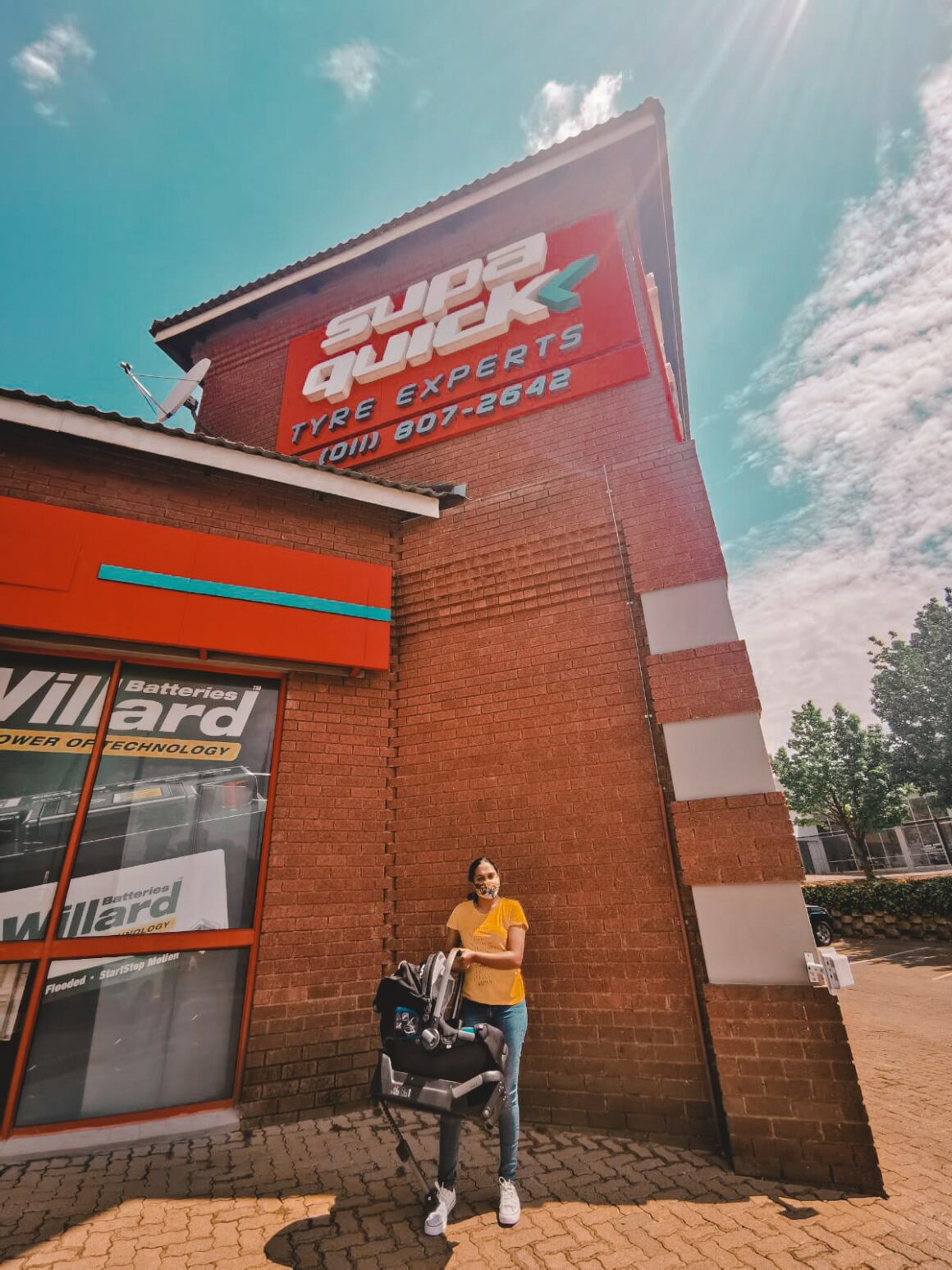This post is sponsored by Supa Quick.
I have heard many moms say: “Well… if she can afford a car, then she should be able to afford a car seat!”

The reality is many families across the country are struggling now more than ever before since Covid-19 has had an enormous impact on jobs and salaries. Some are barely managing to cover the essentials needed to survive.
There could be several reasons why around 93% of South African parents do not strap their kids in when travelling. This stat is alarming, and it is important that we do something about this.

Instead of asking someone why they did not purchase a car seat for their child, hit them with statistics that make them feel so uncomfortable that they realise they need to do something about it.
Here are a few shocking facts:
- Every day 3200 people are killed on roads around the world, with South Africa contributing around 40 deaths per day and 15 000 annually. The country’s mortality rate per 100 000 citizens is one of the worst in the world and the largest unnatural killer of children in South Africa today is road crashes.
- South Africa’s December road death toll is more than that of many countries annually! Drinking and driving contribute to more than 50% of accidents that happen at night.

- Head injuries are the most common injuries sustained by children in motor vehicle crashes regardless of age, restraint, and crash direction.
According to the Centers for Disease Control and Prevention (CDC), a car seat reduces the risk of injury by as much as 82% for children, compared to just using a seatbelt alone. There are several articles that prove this stat.
The National Road Traffic Act states that all children under the age of three years will have to be strapped into a car seat when travelling in a car around South Africa.
Here are 62 facts about car seat safety you may not know but really should.
Not sure what car seat your child needs? Read more here.
The good news is we all can help in some way! You can save a child’s life by donating your baby/toddler car seat to Wheel Well at any Supa Quick store.
Wheel Well collects 2nd hand car seats, refurbishes them, and donates it to moms in need.
How does it work?
- Donate your pre-loved car seat at any Supa Quick drop-off points. Find your nearest branch here.

Supa Quick currently has over 200 fitment centres around the country!
- The car seat will go through a test to check the overall condition of it.
- The car seat will be cleaned and recondition to as good-as-new state and up to EU regulations and standards.
- Donated car seats will be redistributed to lower-income families.
- Car seats that are unsuitable for refurbishing will be recycled.
The goal is to collect 1000 car seats by 2021. Can we do it?!
I did my bit by donating my son’s old car seat and ISOfix at my nearest Supa Quick store. As a content creator, it is my duty to also set an example in anything I encourage you to do.

I am happy that I could contribute towards helping a mom and child in need. More importantly, contributing to an initiative that is so close to my heart.
If you don’t have a 2nd hand car seat to donate, you can also assist by donating what you can to Wheel Well via Snapscan.
Also remember, before a long trip, it is important to do a vehicle safety check. While searching Supa Quick’s website, I came across this amazing freebie which I had to tell you about!
You can get a totally free safety check at any Supa Quick branch so that you know that when you arrive, you will be safe and sound. Plus, this free safety check gets you 200 eBucks just for coming in and getting all those vehicle safety basics covered.

29 comments
Innovative technologies for copper scrap recycling Copper scrap material beneficiation Copper scrap casting
Copper scrap industry analysis Copper refining processes Scrap copper sales and marketing
Copper scrap inventory control Insulated copper wire recycling Copper fitting recycling
Aluminium scrap transformation Aluminium recycling risk management Aluminium recycling resourcefulness
Metal reuse services Ferrous waste disposal yard Iron waste
Ferrous material scrap recovery, Iron scrap salvaging services, Metal waste remanufacturing
Scrap metal melting Ferrous waste recycling plant Iron scrap refining services
Ferrous scrap repurposing, Iron recycling solutions, Ferrous and non-ferrous metals
Metal scrap dismantling Aluminium scrap demand analysis Aluminum scrap treatment
Recycling process optimization, Aluminum cable scrap recycling process, Metal scrap sustainability
Metal waste reprocessing facility Ferrous material recycling seminars Iron scrap recuperation
Ferrous material recycling incentives, Iron scrap reclaimer, Scrap metal documentary requirements
Scrap metal profit margins Aluminium scrap preservation Scrap aluminium transport logistics
Metal scrap reutilization, Aluminum cable scrap recycling rates, Scrap metal valuation
Demolition metal recycling Scrap aluminium utilization technologies Aluminium scrap end-of-life management
Metal waste utilization, Recycling facilities for aluminum cables, End-of-life metal recovery
Scrap metal recovery and reclaiming yard Ferrous metal inventory management Scrap iron reclamation services
Ferrous waste salvaging, Iron waste reclaiming depot, Scrap metal reclaiming solutions
Scrap metal shredding Scrap aluminium repurposing innovations Scrap aluminum sustainability
Scrap metal disposal services, Aluminum cable scrap recycling benefits, Metal scrap recovery and reuse
Scrap metal baling services Ferrous waste compliance Iron scrap exports
Ferrous material recycling waste, Iron waste reclamation and reprocessing, Scrap metal inspection services
Metal waste stream management Scrap aluminum lifecycle analysis Aluminium scrap market outlook
Scrap metal assessment services, Scrap aluminum cable recycling industry, Metal reclamation and recovery center
Scrap metal market intelligence Ferrous material recycling supply Iron scrap reclaiming processing
Ferrous material bulk handling, Iron scrap reclaiming and processing, Metal market analysis services
Scrap metal reprocessing and recovery Aluminum scrap for industrial applications Aluminium scrap repurposing facilities
Scrap metal appraisal, How to recycle aluminum cables, Scrap metal recovery operations
Metal reclaiming and reutilization center Ferrous material recycling performance metrics Iron scrap recovery strategies
Ferrous material environmental sustainability, Iron waste reusing, Metal reclaiming and reclaiming solutions
Scrap metal recovery and reprocessing Aluminium scrap quality assessment Aluminium product recovery
Scrap metal transaction transparency, Aluminum cable recycling challenges, Metal waste reforming
Scrap metal recovery and brokerage Commercial ferrous metal recycling Iron waste recovery solutions
Ferrous, Iron repurposing plant, Industrial scrap metal management
Metal scrap management Aluminum scrap recycling plant Aluminium scrap reprocessing technologies
Metal waste repackaging, Aluminum cable scrap uses, Scrap metal reforming
Scrap metal end markets Ferrous yard safety Scrap iron reclaiming solutions
Ferrous material recycling fleet, Scrap iron reclaiming operations, Advanced metal recycling
Metal scrap reclamation facility Ferrous material recycling awareness Iron and steel reclaiming services
Ferrous material environmental policies, Iron waste reclaiming services, Metal waste recycling facilities
Copper scrap dealers Copper processing efficiency Copper scrap import
Scrap metal recycling industry, Copper recovery specialists, Metal pricing services
Copper transformer recycling Copper has been known and used for thousands of years for its properties such as excellent electrical conductivity, corrosion resistance, and malleability. The manufacturing process of copper involves steps such as mining, concentration, smelting, and refining. Mining: Copper ore is extracted from the earth through either open-pit or underground mining methods. The ore is then transported to a plant for concentration. Concentration: The copper ore is crushed and ground into a powder. The powdered ore is then treated with water and chemicals, which cause the copper minerals to float to the top while the non-copper minerals sink to the bottom. The concentrated copper minerals are then separated from the rest of the materials and sent for further processing. Smelting: The concentrated copper minerals are sent to a smelter, where they are heated at high temperatures in a furnace to remove the sulfur and other impurities. The result is a molten mixture of copper, iron, and sulfur. The copper is then separated from the iron and sulfur using various techniques such as liquation, which involves melting the copper and allowing the impurities to separate based on density. Refining: The raw copper is then refined further to remove any remaining impurities and increase its purity. This process involves electrolysis, where the copper is dissolved in a solution and an electric current is passed through it, causing the pure copper to be deposited on one electrode while any remaining impurities are deposited on another. After the refining process, the copper is formed into various shapes and products using techniques such as casting, rolling, and extrusion. Copper is used in a variety of industries including construction, electrical wiring, and electronics. Overall, the manufacturing process of copper involves multiple steps that require skilled labor and advanced technology to produce high-quality copper products for a range of applications Non-ferrous scrap metal Copper scrap customer service Copper scrap occupational safety Copper scrap circular economy Copper scrap trading network Metal recycling certification
Environmental certifications for copper recycling Copper is a chemical element with the symbol Cu and atomic number 29. It is a soft, malleable, and ductile metal with a reddish-orange color. Copper is a good conductor of electricity and heat and is used in a variety of industries, including electrical and construction. In its pure form, copper is a relatively soft metal that can be easily shaped and molded. However, it is often mixed with other metals to form alloys that have enhanced properties. For example, brass is a copper alloy that contains zinc, while bronze is a copper alloy that contains mainly tin, but also can include other elements such as aluminum and nickel. Copper has a long history of use by humans, dating back to ancient civilizations such as the Egyptians and the Mesopotamians. It was widely used for decorative purposes as well as for making tools and weapons. In fact, the Bronze Age is named after the widespread use of bronze, which is a copper alloy. Today, copper is used for a variety of purposes, including electrical wiring, plumbing pipes, and jewelry. It is also used in industrial processes such as the production of electronics, transportation equipment, and building materials. Copper is an essential mineral for human health, with a daily recommended intake of 900 micrograms for adults. It plays a role in the formation of red blood cells, helps with the absorption and use of iron, and is important for maintaining a healthy immune system. Despite its usefulness, copper can also be toxic if ingested in large amounts, and exposure to high levels of copper can cause health problems such as nausea, vomiting, and liver damage. Overall, copper is a versatile and important element that has played a significant role in human civilization for thousands of years. Its unique properties make it useful in a wide range of applications, from everyday objects to advanced technologies Scrap metal insurance Scrap copper warehousing Copper scrap route optimization Copper scrap buyers and sellers Copper recovery technology Scrap metal exporters
Scrap copper sorting Copper derivative products Metal scrap inspection
Copper cable scrap export destination, Metal waste brokerage, Copper scrap importers
Scrap metal reclamation and recovery solutions, Copper recycling plant, Cable stripping machines, Metal scrap retrieval
Metal reclamation site Scrap metal waste reduction Iron and steel scrapping and recycling
Ferrous waste reprocessing plant, Iron scrap reclaiming plant, Metal waste shearing
End-of-life metal recovery Ferrous shred quality Iron scrap reclamation plants
Ferrous metal inspection, Iron disposal facility, Scrap metal transportation
Scrap metal export procedures Ferrous material recycling inventory Iron scrap disassembly
Ferrous material industry benchmarking, Iron scrap salvage operations, Scrap metal recycling methodologies